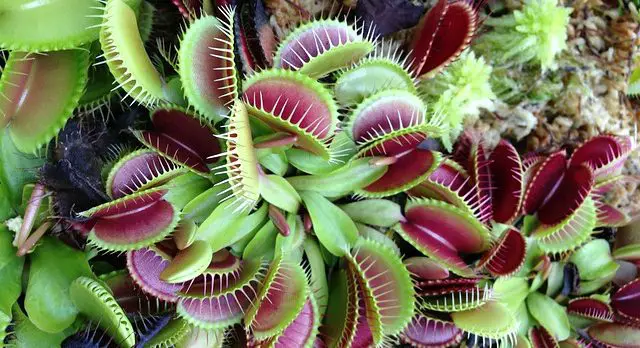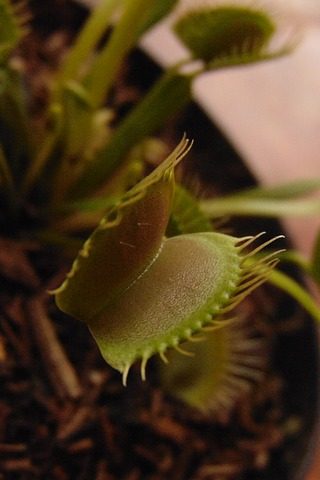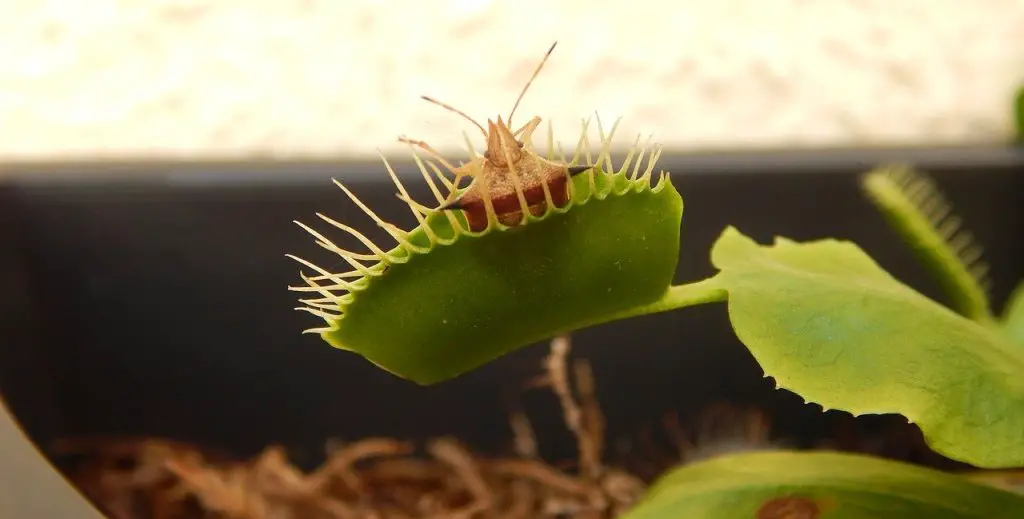Venus flytraps are native to the wetlands on the east coast of the United States. Specifically, they are found in the states of South Carolina and North Carolina. Most people are familiar with these plants due to their carnivorous nature. Yes, they eat meat! Most plants get their vital nutrients from the soil, but Venus flytrap habitats do not contain enough nutrients. Therefore, Venus flytraps must catch prey and feed themselves to obtain Nitrogen, Phosphorus, Potassium, and other elements. Their diet is based mostly on insects, yet, big plants might catch some small reptiles or rodents. When I got my first Venus flytrap, I was extremely excited about feeding it. However, I did not know how to do it. After some in-depth research, I came up with a reference guide to feed my Venus flytraps properly. In this article, I will share this guide with you:

Venus Flytrap Feeding Mechanism

First, Venus flytraps must attract their prey before they catch them. Their traps produce a sweet nectar that attracts insects. Once the insect has landed inside a trap, it may or may not create enough stimulus to trigger the trap. Each trap is made up of two leaves. Each leaf has three hair cells arranged in a triangular pattern [1]. The trap will close only if the insect touches the hair cells inside the trap two consecutive times. Venus flytraps develop the double stimuli requirement to avoid closing due to rain, dirt, or any inanimate object touching the trap. The process of closing the hatch drains energy from the plant, and Venus flytraps want to be as efficient as possible.
Once the prey is captured, the Venus flytrap might release the victim. For example, when the insect is tiny, it will be able to scape. Also, Venus flytraps have evolved over the years to select their prey appropriately.
“Among carnivorous plants, the Venus flytrap is of particular interest for the rapid movement of its snap-traps and hypothesized prey selection, where small prey are allowed to escape from the traps (…) Specifically, we analyze the dynamics of prey capture; the costs and benefits of capturing and digesting its prey; and optimization of trap size and prey selection.” Understanding the Venus flytrap through mathematical modelling
, Sami Lehtinen
The excerpt above is from an interesting Theoretical Biology paper. In this study, scientists observed that Venus flytraps allowed the scape of their prey 76.8% of the time. The high percentage indicates these plants are highly selective about prey capture. Venus flytraps select their prey carefully to maximize efficiency. Once the plant has caught prey, it will take several days to consume it entirely. Generally, the whole process takes between one to two weeks.
How to Feed a Venus Flytrap?
What to feed?
In the wild, Venus flytraps catch crickets, beetles, grasshoppers, spiders, slugs, flies, and ants. You can feed your plants with any of those insects. The only restriction comes from the size. Make sure the insect fits in the trap, and that the trap can close completely while the bug inside(more details below, under prey size). It is not always easy to catch live insects, but luckily you have other options. You can buy Venus flytrap food online. Some standard options are freeze-dried bloodworms and mealworms.
Live or Dead Prey
You can feed live or dead prey to your Venus flytrap. Yet, the process will be quite different.
Live insects move around. You might have difficulty handling the bug and depositing it into a trap. Some people put the bugs in contact with ice or some very cold surface to stunt it for a few minutes. Once the bug is inside the trap, its initial movement will activate the trap. The insect will try to fight its way out, but the movement will only make it worst. The plant will confirm it caught live prey and will keep its traps fully shut and will start producing enzymes.
Venus flytraps do not eat dead prey. They are designed to only activate their traps due to active stimuli. When you introduce a dead insect, make sure to stimulate those hair cells mechanically. Once the trap is closed, your job is not over. The plant will notice the lack of stimuli and open again if you do not do anything else. Instead, you must use your hands or tweezers to pressure the center of the trap on both sides. The goal is to mechanically stimulate those leaf hairs, and get the enzymes flowing.

Personally, I have alternated between live and dead prey over the years. Sometimes I even let my plants catch their own prey. Every week or two, I deep clean my home and leave the doors and windows open to ventilate all rooms. There is always a fly or small bug that gets indoors. It is not uncommon that later that day, I would notice one of my Venus flytraps has caught prey.
Frequency
Venus flytrap owners sometimes get too excited about feeding their plants and can overfeed them. Overfeeding won’t kill the plant directly, but it can severely weaken it and eventually kill it.
Venus flytraps only need to eat once every two to four weeks. Also, they shouldn’t be fed during dormancy (late fall and winter). When you do have to feed it, use a single insect, and feed it to one trap. Those nutrients will translate to the entire plant. If you notice that a trap is still digesting a previous prey, you can wait to feed your plant until it has finished.
A Venus flytrap can survive for months without consuming any bug. However, the lack of food won’t let the plant develop properly. It might not die, but its growth will slow down significantly.
Prey Size
A common mistake for novice Venus flytrap growers is picking the wrong prey size. The rule of thumb is to choose an insect that is 1/3 of the size of the trap. Anything larger than that will be too difficult to digest. If the trap is not able to close entirely and digest its prey, the leaf will turn black and die. Every once in a while, you could make a mistake, but if you follow this sizing recommendation, you will avoid losing leaves and waisting your plant’s energy.
Related Questions: Venus Flytrap Feeding
Can I feed bread, fruit, or any human food to my Venus flytrap?
No. Every time you ask yourself if it is ok to use human food to feed your Venus flytrap, the answer will be a hard “No”. Venus plants aren’t designed to consume human food. If you feed it to them, they might close the traps and attempt to digest it. But they will most likely be unsuccessful. Ultimately, you can kill the trap or even the whole plant due to bacterial infections.
Why is the trap turning black after feeding?
Venus flytraps are continually growing and developing. Traps will turn black, and new ones will spur. It is normal for traps to dry off. However, if you just fed the plant, and suddenly it is drying out. Then, that last meal might have been too big. When the meal is too large, the plant will give up in the process, and the leaf wither.
Related Advice
Generally, I do not have the best memory. So, my strategy is to record important information in writing or digitally. When I first started growing carnivorous plants, I would always forget their feeding schedule. But, I really wanted to be successful and provide proper care. Then, I started a mini notebook diary, where I recorded each time I fed my plants and all the related details (which bugs I used, if the traps turned dark, and general health observations). If you think this could be useful for you, consider taking my advice and starting a Venus flytrap diary!
Sources
[1] http://www.plantphysiol.org/content/146/2/694
https://www.sciencedirect.com/science/article/pii/S0022519318300560
Has your Venus flytrap flower yet? Read this flower care guide  for more information:
for more information:

